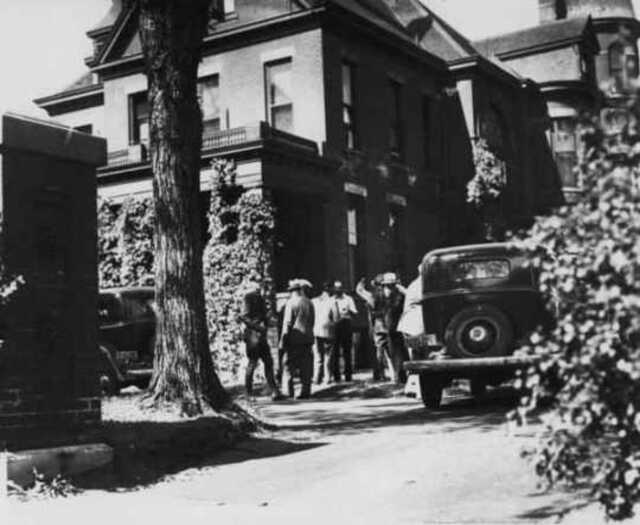Miles from the city, near the Wisconsin border, the sedan stopped and more men joined in another car. With Hamm Jr. still on the car floor, the gangsters forced him to sign four ransom notes. These notes demanded a ransom of $100,000 (equivalent to over $2 million in 2024 dollars). The notes designated William Dunn, the brewery's sales vice president, as the contact person for the ransom exchange. William Hamm Jr. was then moved to a hideout in Bensenville, Illinois where he was held until the ransom was paid.
He was taken to a rented bungalow which served as the gang's primary hideout for their kidnapping operations. Confined upstairs, Hamm Jr. was kept in a small, dimly lit room where the windows were boarded up or heavily covered to prevent any view outside. The furnishings were sparse, likely just a bed or cot. He was given instructions to call out if he needed anything, but was ordered to turn away from the door and face the wall whenever his captors entered the room, a tactic designed to prevent him from identifying them. His captors were Alvin Karpis, Fred Barker, Arthur "Doc" Barker, and Bryan Bolton, among others who rotated in and out as guards.
Despite the gang's strict "no police" rule, the Hamm family did not comply, with brewery VP William Dunn immediately alerting St. Paul Police Chief Thomas Dahill and the FBI, who launched an investigation due to the interstate nature of the crime. That evening, Dunn received the ransom demand of $100,000 in small, unmarked bills, and early on June 16, 1933, a taxi driver delivered a threatening ransom note stating: "You know your boyfriend is out of circulation. You are to pay off $100,000 in a manner explained...If you fail to comply, you will never see William Hamm Jr. again." Determined to secure his release, the family withdrew the ransom from a Minneapolis bank and prepared to deliver the money.
At 9 AM Saturday, Dunn received another call instructing him to drive to Hamm Realty employee L.J. Sullwold's home, where the pre-informed Sullwold directed him to take the ransom in the modified Hamm's truck and drive along Highway 61 toward Duluth under 20 mph until a vehicle flashing headlights five times signaled the exchange point. Dunn followed these instructions, dropped the money bag roadside, and continued to Duluth where he registered at the Hotel Duluth expecting Hamm's arrival, but when the victim never appeared, St. Paul Detectives Tom Brown and Charles Tierney joined Dunn to anxiously await the kidnap victim's return.
On the afternoon of June 18, 1933, Hamm's kidnappers entered his room with good news - the ransom was paid, and he was going home. After a long overnight drive, the blindfolded Hamm was dropped off at 5:30 AM on June 19th along Highway 1 near Wyoming, Minnesota. His captors instructed him to remain on the side of the road as they escaped. Once he was sure they'd left, Hamm walked to a nearby family farm and used their phone to call home. A short time later, Chief of Police Thomas Dahill announced to the press he was leaving for Wyoming to pick up Mr. Hamm.
The kidnapping left Hamm Jr. living in fear of being taken again, prompting extreme precautions. Publicly calm yet privately shaken, the once-embraced celebrity now shunned the spotlight. He continued using the bluff stairs to work but only with armed escorts. The pleasant, well-liked personality became nervous and introverted, his home transformed into a heavily-guarded feudal castle. Efforts to avoid public attention extended to wearing overalls instead of suits at the brewery to blend in.
Though the gang collected the ransom and released Hamm unharmed, this event—and the subsequent Bremer kidnapping months later—ignited significant public outrage against criminals. While Hamm's court testimony later confirmed his transport across state lines, federal involvement was immediate, initiated under the Lindbergh Law. This swift federal action, coupled with the groundbreaking Silver Nitrate Fingerprint Method, proved instrumental in the eventual capture of his captors. The traumatic event, however, was not simply "behind him." William Hamm Jr. remained profoundly affected, living the rest of his life in fear and reclusion, a stark and permanent change from his former public persona.
 Minnesota Then
Minnesota Then

